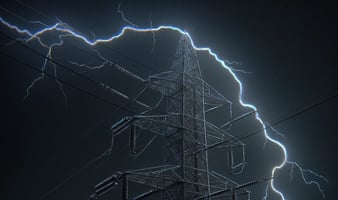Investor-owned utilities (IOUs) are encountering a growing threat from physical climate risks,...
The Impact of AI on Managing Enterprise-Level DERs
Distributed Energy Resources (DERs) are often heralded as the next revolution in electricity generation, offering a significant means to cut greenhouse gas emissions and combat climate change. However, the transition to DERs is not a future concept—it's already unfolding. In 2022, Forbes reported that solar installations in the U.S. had surpassed 120 GW, with about half of this capacity being distributed. Additionally, close to 12 GW of battery storage had been connected to the grid. That same year, the Department of Energy forecasted that over $110 billion worth of DERs would be deployed nationwide by 2025.
Distributed Energy Resource Management Systems (DERMS) facilitate integrating, controlling, and optimizing DERs such as solar panels, wind turbines, and energy storage solutions across the power grid. Integrating Artificial Intelligence into DERMS is critical in managing these resources when scaling up to millions of DERs to enhance efficiency, sustainability, and operational capability at an enterprise level.
Superiority of AI-Enabled DERMS for Scalable Operations
The proliferation of DERs has introduced complexity and variability that traditional systems need to be equipped to handle efficiently.
One of the foundational strengths of AI-enabled DERMS is the ability to process and analyze large volumes of data from a myriad of DERs across the grid. Here are reasons why this capability is critical:
- Real-time Monitoring: Continuous, real-time monitoring of DER performance, grid conditions, and energy demand allows for immediate responses to changes, ensuring grid stability.
- Predictive Analytics: AI algorithms can forecast energy production from renewable sources and predict demand patterns, enabling proactive grid management to balance supply and demand effectively.
Unlike traditional systems, which (at very best) operate based on fixed algorithms and parameters, AI-enabled DERMS are dynamic learning systems. They improve over time by:
- Adapting to New Conditions: As AI systems process more data, they refine their algorithms to predict better and manage grid dynamics, accommodating new DERs and changing consumption patterns.
- Optimizing Performance: Continuous learning enables AI-driven DERMS to optimize energy distribution, improve the efficiency of renewable energy utilization, and reduce wastage through more accurate forecasting and better decision-making processes.
The diverse nature of DERs, each with its own operational characteristics and connectivity protocols, poses a significant challenge for grid management. AI-enabled DERMS excel in:
- Managing Diversity: They can integrate various types of DERs, ensuring they operate harmoniously within the grid.
- Ensuring Interoperability: AI-driven systems facilitate communication and coordination among DERs, enhancing grid resilience and flexibility.
Grid stability is paramount, especially with the increasing reliance on variable renewable energy sources. AI-enabled DERMS contribute to stability by:
- Balancing Supply and Demand: These systems can dynamically balance energy supply with consumer demand through predictive analytics and real-time monitoring, even under fluctuating conditions.
- Responding to Disturbances: AI systems can quickly identify and respond to grid disturbances, rerouting power or adjusting DER outputs to maintain grid integrity.
AI in Large-Scale Energy Forecasting and Management
The capability of AI to analyze vast arrays of historical and real-time data from millions of DERs allows for unprecedented accuracy in predicting energy demand and generation patterns.
Traditional forecasting methods, which often rely on historical trends and simpler statistical models, cannot adequately account for the variability and complexity introduced by renewable energy sources like solar and wind. AI algorithms, however, can digest complex datasets, including weather patterns, seasonal variations, and user behavior, to make highly accurate predictions about energy generation and demand.
Furthermore, the accurate forecasts AI provides are crucial for dynamic load balancing. This process involves adjusting the energy supply from various sources in real time to meet the fluctuating demand without overloading the grid. By predicting peak times and potential energy surges, AI enables grid operators to manage resources dynamically, ensuring a stable and reliable energy supply. This capability is vital because more intermittent, renewable energy is injected into the grid.
Automated Decision-Making for Efficiency at Scale
The automation capabilities of AI within DERMS represent a transformative shift in how energy resources are dispatched and controlled.
AI enables the real-time, automated dispatch and control of DERs, essential for maintaining grid stability and efficiency. AI algorithms can rapidly decide when and where to dispatch energy resources by analyzing data from various sources. This includes turning renewable energy sources on or off, managing storage systems, and controlling demand response events. Automating these processes reduces the need for manual intervention, making the management of DERs more efficient and less prone to error.
As the number and variety of DERs on the grid continue to grow, AI's automation capabilities enable DERMS to scale up without a proportional increase in complexity or operational challenges. This scalability ensures that the grid can adapt quickly and efficiently as new technologies emerge and consumer behavior changes. This adaptability is crucial for ensuring the long-term sustainability and resilience of the energy grid.
Stabilizing the Grid with AI
Integrating renewable energy sources is pivotal for meeting sustainability goals, but it introduces challenges due to the variability of these sources. The objective is to manage these fluctuations effectively to ensure the electricity grid's reliability.
A significant hurdle with renewables such as solar and wind is their reliance on weather conditions, leading to unpredictable energy generation. We can use AI's advanced algorithms to analyze historical weather data and energy production patterns accurately to predict these fluctuations. This predictive capability enables grid operators to anticipate high or low energy production periods, improving resource management and grid stability.
The proactive nature of AI allows for swift adjustments in response to changing conditions, thereby reducing the risk of power outages and ensuring a consistent electricity supply. By optimizing the integration and utilization of Distributed Energy Resources (DERs), AI contributes to building a more resilient grid.
Moreover, AI-driven insights and automation offer significant benefits in terms of operational efficiency, cost reduction in grid management, and enhanced service reliability for consumers. Utilities can leverage AI to adapt to current conditions and plan for future scenarios, including necessary infrastructure investments to accommodate the increasing share of renewable energy sources.
A stable grid capable of accommodating a higher percentage of renewable energy contributes to the overarching goal of reducing greenhouse gas emissions and transitioning towards more sustainable, decentralized, and consumer-centric energy systems.
AI-Driven Optimization of Demand Response and Maintenance
In managing millions of Distributed Energy Resources (DERs), AI's capabilities extend beyond grid stability to optimize demand response strategies and improve the maintenance and longevity of DERs.
Studies by institutions like the Electric Power Research Institute (EPRI) have shown that AI-enabled demand response programs can significantly shift peak load. Demand response programs are designed to manage consumers' energy consumption during peak usage times to reduce strain on the grid. AI enhances these programs by:
- Predicting Peak Usage: Using historical data and real-time analytics, AI algorithms can accurately forecast periods of high energy demand. This predictive capability allows utilities to plan demand response events more effectively and precisely.
- Facilitating Energy Redistribution: AI enables dynamic adjustments to energy distribution during peak times. It can automatically adjust DER operations, such as reducing energy consumption in industrial processes or temporarily increasing the output from energy storage systems, to balance the grid without compromising service reliability.
Predictive Maintenance for DERs
Predictive maintenance involves using AI to analyze data from DERs to predict potential failures before they occur. This approach has several benefits:
- Reducing Downtime: Texas has recognized the importance of DERs in enhancing grid reliability and resilience, particularly in the wake of extreme weather events, and is actively working on expanding and integrating DERs within its energy system. One notable initiative in the state is expanding an 80 MW distributed energy resource pilot aimed at harnessing flexible resources to improve grid reliability. Finally, between 2000 and 2022, Texas experienced the highest number of power outage events affecting at least 50,000 customers, followed by California and Michigan. With AI-enabled DERMS, utilities in Texas and nationwide can schedule repairs for DERs before a failure occurs by predicting when maintenance is needed, significantly reducing unplanned downtime. This ensures a continuous and reliable energy supply.
- Cutting Maintenance Costs: According to a 2023 report by Deloitte, the U.S. utility industry spends an average of $14.6 billion annually on distribution system operations and maintenance. Predictive maintenance can identify specific components needing attention, avoiding unnecessary routine maintenance costs. This targeted approach can lead to substantial cost savings over time.
- Ensuring Longevity of DERs: Reports by the American Society of Civil Engineers (ASCE) state that transmission spending in the U.S. rose from $15.6 billion in 2012 to $21.9 billion in 2017, driven by the need for more reliable, secure, and resilient infrastructure and to facilitate access to clean energy sources. The challenges of aging infrastructure are compounded by increasing demand and the integration of renewable energy sources, underscoring the need for strategic investment in grid modernization and resilience measures. As the grid evolves, utilities will continue to seek innovative solutions and technologies to improve asset longevity, enhance grid performance, and meet future energy needs. Regular maintenance, informed by AI's predictive analytics, can extend the operational life of DERs. These resources' overall health and efficiency are maintained by preventing wear and tear through timely interventions.
Economic Advantages and Energy Trading
As reported by BloombergNEF, AI enables higher enterprise returns through more efficient and strategic trading decisions. Within the energy sector, that's particularly true in energy trading. AI algorithms can process and analyze large datasets more efficiently than traditional methods. This capability enables them to identify patterns, trends, and correlations in the energy market that might take time to be apparent. By understanding these dynamics, traders can make more informed decisions, timing their buys and sell to maximize profitability or minimize costs.
AI's predictive capabilities benefit direct trading and enable strategic utilization of energy resources. For example, knowing when energy prices are likely to peak, a utility or energy provider can decide to sell excess energy generated from DERs at the most opportune moments, enhancing returns. Conversely, they can store energy or reduce production when prices are low, optimizing their energy portfolio.
Finally, AI systems can analyze market data constantly and adjust trading strategies accordingly. This allows for the automation of certain trading decisions, where AI algorithms can execute trades within milliseconds of identifying an opportunity.
Conclusion
Integrating AI into the management of DERs brings forth a revolution in how enterprise-level DERs are handled. As we stand on the brink of this transformation, it's clear that AI-enabled DERMS is not just an enhancement but a necessity for the future of energy management. These systems offer unparalleled advantages over traditional methods, including superior data processing capabilities, predictive analytics, dynamic learning and adaptation, seamless integration, and interoperability among diverse energy resources.
AI's role extends beyond operational efficiency, touching upon economic benefits through optimized energy trading and strategic resource utilization, heralding a new era of financial savvy in energy markets. Moreover, AI-driven DERMS ensure grid stability, a crucial factor as the world leans more towards variable renewable energy sources. Through automated decision-making, predictive maintenance, and demand response optimization, AI-enabled systems promise a grid that is more efficient, reliable, and capable of accommodating the growing complexity and scale of DERs.


